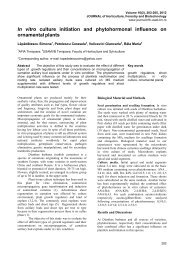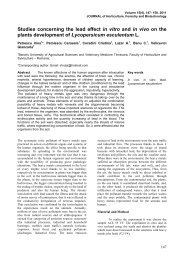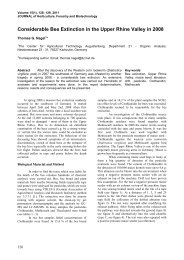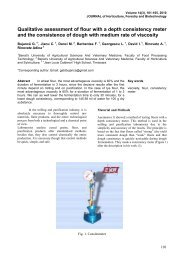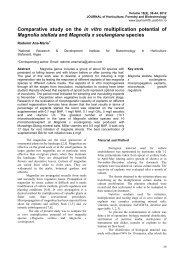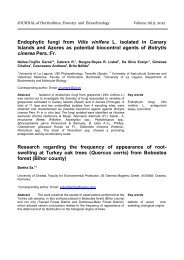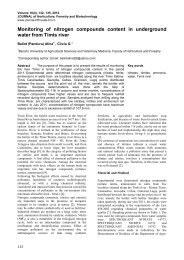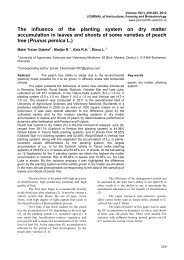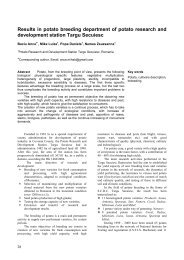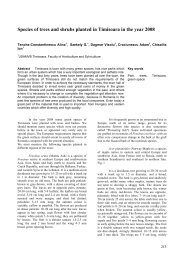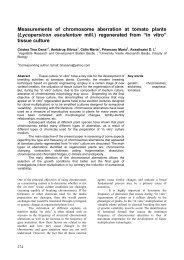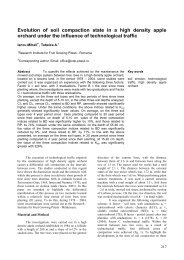Research concerning the composition and organoleptic features
Research concerning the composition and organoleptic features
Research concerning the composition and organoleptic features
You also want an ePaper? Increase the reach of your titles
YUMPU automatically turns print PDFs into web optimized ePapers that Google loves.
Ottonel, Pinot noir, <strong>and</strong> Cabernet Sauvignon.The quality of <strong>the</strong> wines depends first on <strong>the</strong> quality of <strong>the</strong> rawmaterial <strong>and</strong> <strong>the</strong>n on <strong>the</strong> preparation <strong>and</strong> conditioning technology. Toestablished correlations between production <strong>and</strong> wine quality <strong>and</strong> with climateconditions, we made measurements <strong>concerning</strong> <strong>the</strong> grapes‟ degree of health,sugar content, <strong>and</strong> acidity upon harvesting. We also measured <strong>the</strong> maincomponents of <strong>the</strong> wines <strong>and</strong> <strong>the</strong>ir <strong>organoleptic</strong> <strong>features</strong>. Measuring alcoholcontent allowed <strong>the</strong> ranging of <strong>the</strong> studied wines in a certain category:superior or current consumption.As a result of our research on wine <strong>composition</strong> <strong>and</strong> <strong>organoleptic</strong> <strong>features</strong>, werecommend <strong>the</strong> use of some red <strong>and</strong> white grape cultivars with superior yieldsin <strong>the</strong> conditions of <strong>the</strong> studied area.<strong>Research</strong> <strong>concerning</strong> <strong>the</strong> impact of sulphurous anhydride ondemisec <strong>and</strong> demisweet wine maturationGhiţă Alina 1* , Dobrei A. 1 , Iordănescu Olimpia 1 , Mălăescu Mihaela 1 , Drăgunescu Anca 1 ,Cristea T. 11 USAMVB Timisoara, Faculty of Horticulture <strong>and</strong> Sylviculture*Coresponding author. Email: ghitaalina@yahoo.comAbstract We have made observations <strong>and</strong> measurements in a privatewinery from Buziaş (Timis County) on <strong>the</strong> wines from <strong>the</strong> grape cultivarsFetească albă, Sauvignon, <strong>and</strong> Pinot gris aiming at identifying <strong>the</strong> optimaldosage of sulphurous anhydride that ensures <strong>the</strong> reducing evolution duringmaturation in <strong>the</strong> barrel of demisec <strong>and</strong> demisweet wines.The condition for a wine to become valuable, with particular<strong>organoleptic</strong> <strong>features</strong>, is to go through several stages: formation, maturation,<strong>and</strong> ageing; during maturation <strong>and</strong> ageing, <strong>the</strong>re are a lot of changes that give<strong>the</strong> wine <strong>the</strong> <strong>features</strong> <strong>and</strong> qualities specific to <strong>the</strong> grape cultivar.Since preserving primary aroma, colour, <strong>and</strong> fructuosity is <strong>the</strong> mainelement of reducing wines, it is compulsory to maintain oxidation as low aspossible in <strong>the</strong> maturation recipients: in this process, using sulphurousanhydride is important. It also contributes to <strong>the</strong> formation of <strong>the</strong> bouquet in<strong>the</strong> bottle <strong>and</strong> of <strong>the</strong> sulphitic bouquet.<strong>Research</strong> focused on several moments of wine technology ofreducing demise <strong>and</strong> demisweet wines meant to improve as much as possible<strong>the</strong> quality <strong>features</strong> of <strong>the</strong>se types of wine.<strong>Research</strong> results showed that using higher rates of sulphurous anhydride ininitial sulphitation we eliminate <strong>the</strong> necessity of sulphitation during barrelmaturation <strong>and</strong> maintaining a constant ratio between total <strong>and</strong> free SO 2 ispossible only through re-sulphitation.Key wordswine maturation, winesulphitation, demisec <strong>and</strong>demisweet winesThe behavior of some new chrysan<strong>the</strong>mum cultivars(Chrysan<strong>the</strong>mum indicum L.) cultivated in pots, in greenhouseconditionsBăla Maria 1 *, Berecici D.N. 11 University of Agricultural Sciences <strong>and</strong> Veterinary Medicine Timişoara, Faculty of Horticulture <strong>and</strong> Forestry*Corresponding author. Email: mariabalamonicabala@yahoo.com



